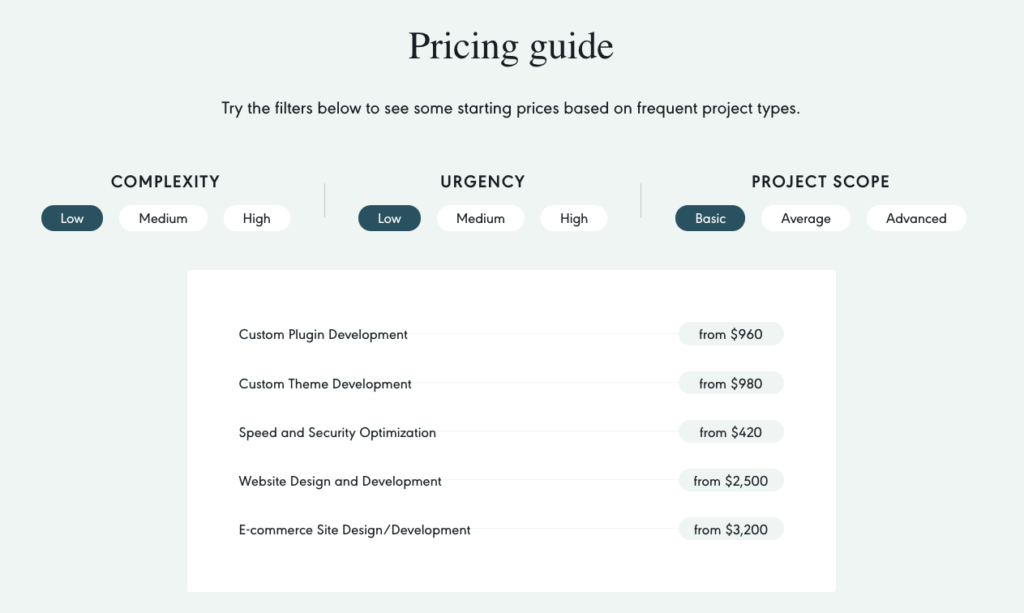You know you need a professional website, but the moment you start looking, you’re hit with a bewildering range of prices. Quotes for what seems like the same project can swing from a few hundred dollars to tens of thousands, leaving you paralyzed with uncertainty.
The key to clarity is shifting your perspective: your website isn’t just an expense to be minimized, it’s your most critical business asset. It functions as your 24/7 sales representative, primary marketing channel, and the central hub for your brand’s identity.
Which is why we’ll provide a clear framework for answering the essential questions you’re facing: Is an hourly or fixed-price project better? What’s a realistic budget for a professional site? And what are the hidden risks of choosing the cheapest option?
Let’s demystify the numbers and empower you to make a confident, strategic investment in your company’s growth.

Get matched with the developer
that is perfect fit for your WordPress or WooCommerce needs.
Start a project
What factors influence WordPress developer pricing?
A professional developer’s quote isn’t an arbitrary number pulled from thin air. It’s a careful calculation based on the time required to complete the work. At Codeable, project pricing is primarily shaped by three key factors: the project’s scope, its complexity, and its urgency.

Understanding these elements will help you decode price estimates and make smarter budget decisions.
Scope: The “what” and “how many”
Scope defines the total volume of work to be done. While it seems straightforward, the cost isn’t always what you’d expect. The two biggest factors are page templates and data migration.
Unique page templates
It’s a common mistake to think that project cost scales with the total number of pages. The real cost driver is the number of unique page layouts a developer has to design and build.
Example: A 50-page website using just three distinct templates (e.g., a homepage, a standard blog post, and a contact page) will cost significantly less than a 15-page website where every single page has a completely unique, custom design.
Content and data migration
This task is very easy to underestimate. Do you have an old website, blog, or store? Moving that existing content is a manual, time-consuming job that will be factored directly into the project cost. This includes tasks like:
- Manually copying and reformatting hundreds of blog posts.
- Exporting and importing thousands of customer records from a legacy e-commerce platform.
Complexity: The “how hard”
Complexity refers to the level of skill and effort needed to build your site’s features. This is often the largest and most variable part of any quote.
Design customization
This exists on a spectrum. The path you choose will heavily influence the price.
- Less complex: A developer customizes a high-quality, pre-built premium theme to match your logo, fonts, and brand colors.
- More complex: A fully custom theme design. This involves creating wireframes, detailed mockups, and building a unique user experience (UX) from the ground up. This bespoke approach commands a much higher price.
Custom functionality
Adding a blog or a simple contact form is standard. Building advanced, specialized features is not.
Examples of complex functionality include:
- E-commerce: Setting up a full online store with product variations, shipping rules, and payment gateways (like Stripe or PayPal).
- Membership sites: Creating a system with protected content, different user levels, and recurring subscription billing.
- Custom systems: Developing a unique booking/reservation system, a learning portal (LMS), or a detailed event calendar.
- Integrations: Connecting your website to third-party tools (like a CRM, marketing automation platform, or inventory system) adds a significant layer of technical work.
Urgency: The “how soon”
Urgency is a direct cost multiplier. Projects with aggressive or rushed timelines will always have a premium price. This isn’t a penalty for working faster, but rather a fair compensation for the cost of disrupting a developer’s entire workflow. An urgent request forces them to reschedule other client commitments and work outside of standard hours.
You can think of this urgency premium as a “tax on poor planning”, and it is a completely avoidable expense.
One of the most effective ways to save money is to invest time in planning. You can eliminate this premium and significantly reduce the final price by:
- Preparing a detailed project brief.
- Gathering all your assets (logos, images, text) before the project starts.
- Allowing for a realistic and flexible timeline.
Choosing the best pricing model for your WordPress project
To pay a developer an hourly rate or a fixed project fee? That is the question!
These different billing methods show different ways of managing projects and how flexible they can be. They also determine who takes on the financial risk. To make a smart choice, the first important step is understanding the pros and cons of each method.
The fixed-price contract for predicatability
In a fixed-price model, you and the developer agree on a single, total cost for the project based on a very detailed scope of work. Payments are often tied to key milestones and held in a neutral escrow account to build trust.
The biggest advantage: Budget predictability. You know the total financial commitment from day one, which eliminates the risk of surprise invoices or cost overruns.
Best for: Projects where requirements are crystal-clear and unlikely to change, such as simple brochure websites or the development of a Minimum Viable Product (MVP).
The major drawback: A profound lack of flexibility. Any new idea or change request, known as “scope creep”, falls outside the original agreement and requires a formal renegotiation, leading to new quotes and potential delays. To protect themselves from unforeseen issues, experienced developers often build a risk buffer into their quotes, which can sometimes make a fixed-price project more expensive than an hourly one.
The hourly rate model for flexibility
Also known as a “Time and Materials” contract, this model is a more fluid arrangement where you agree to pay a set hourly rate for the actual time a developer works on your project. In such cases, developers typically use time-tracking software to provide detailed timesheets with their invoices.
The biggest advantage: Flexibility. The project scope can evolve, new features can be added, and priorities can shift without having to renegotiate the entire contract.
Best for: Complex, long-term projects, research and development phases where the final outcome isn’t fully known, or ongoing maintenance tasks.
The major drawback: Budget uncertainty. It’s nearly impossible to accurately forecast the final cost at the start, placing the financial risk of delays or unexpected challenges squarely on you, the client. This model requires a high degree of trust to mitigate concerns about inefficient work or “padded” hours.
A hybrid solution: The best of both worlds
The fundamental difference between these models is how they allocate risk. With an hourly rate, the client assumes the risk of cost overruns. With a fixed price, the developer assumes the risk of underestimating the work. This tension has led to innovative hybrid models designed to offer the best of both worlds.
On a platform like Codeable, the process is designed to provide certainty. After you submit a project brief, a pool of pre-vetted experts independently provides confidential estimates based on the time they think the work will take, calculated against a standard professional hourly rate of $80-$120. The platform then aggregates these expert estimates and presents you with a single, fair, fixed-price average.
This elegant solution gives you the primary benefit of a fixed-price contract, i.e., budget certainty, while ensuring the developer is compensated fairly based on a professional hourly rate.
The service fee funds the platform’s critical infrastructure, including the expert vetting process, 24/7 customer support, and quality guarantees that protect your investment.
This transforms the relationship from an adversarial negotiation into a collaborative partnership focused on a high-quality outcome.
The hidden costs of hiring cheap WordPress developers
In a market with wide price variations, the temptation to opt for the lowest bidder can be immense for a budget-conscious business. However, this is a risky strategy. The initial savings are frequently misleading, masking a future of technical problems, security risks, and lost business opportunities that end up costing far more in the long run.
Technical debt accumulation
“Technical debt” is a term for the future rework you’ll have to pay for because you chose an easy or limited solution now instead of a better, more robust one. Hiring a cheap developer is one of the fastest ways to accumulate it due to:
- Poor code quality. Low-cost developers often lack the experience to write clean, efficient code. They might rely on a patchwork of bloated, low-quality plugins or take shortcuts that compromise your site’s performance, resulting in a website that is slow, buggy, and prone to crashing.
- Lack of scalability. The long-term result is a site built on a fragile foundation. While it may function at launch, it will likely break under increased traffic, fail when you try to add new features, or become incompatible with future WordPress updates. This forces you into a cycle of expensive bug fixes or a complete, costly rebuild far sooner than anticipated.
Security and reputation exposure
The consequences of poor development extend far beyond technical glitches, as they create tangible business liabilities.
- Security vulnerabilities. Inexperienced developers often neglect fundamental security best practices, leaving a website riddled with vulnerabilities to hackers, malware, and data breaches. A compromised website can lead to stolen customer data, getting blacklisted by search engines like Google, and even severe legal and financial penalties.
- Reputational damage. A website that is poorly designed, slow to load, or difficult to navigate reflects poorly on the brand itself. This erodes customer trust and can drive potential clients directly to your competitors before you even have a chance to interact with them.
Measurable revenue loss
The money you “save” on cheap development is often erased by lost revenue.
- A slow-loading or buggy e-commerce site leads directly to abandoned shopping carts.
- A confusing lead generation form results in fewer inquiries from potential customers.
- Poor on-site SEO, which is a common oversight with cheap development, leads to lower search engine rankings and less organic traffic.
Hidden operational inefficiencies
Many times, the financial damage is often compounded by operational frustrations. Projects with low-cost developers are frequently plagued by poor communication and chronically missed deadlines.
A common tactic is for the developer to disappear after the final payment, leaving you stranded with no support when a critical bug emerges. This often leads to the painful realization that you must hire a second, more expensive professional to either fix the mess or start over from scratch.
Hiring a cheap developer will almost certainly lead to poor results, and it won’t save you money in the long run. Don’t think of it as choosing between a $500 developer and a $5,000 developer. Instead, consider that you’re choosing to avoid a high-risk problem costing over $10,000 and gaining a valuable, high-performing asset.
WordPress website pricing guide with real examples
To answer the question, “What’s a realistic budget for a professional website?”, it helps to think in tiers.
While every project is unique, most small business websites fall into one of three common categories. The following budget ranges are based on real-world project data and account for the complete process of strategy, design, development, and launch.
Keep in mind that a comprehensive budget includes two distinct parts: the one-time project cost to build the site, and the ongoing operational costs to own and maintain it.
One-time project cost: The build
This is the upfront investment to get your website designed, developed, and launched.
| Professional brochure site: $2,500 – $7,500. This is perfect for businesses that need a strong, professional online presence to showcase their services and generate leads. Common features include: 5-10 unique pages with a fully custom design aligned with your brand identity. A blog or news section for content marketing. Advanced contact or lead-generation forms. Foundational Search Engine Optimization (SEO) setup and mobile-responsive development. | Small e-commerce store: $5,000 – $15,000. For businesses ready to sell products online, this tier includes everything in the brochure site, plus the essential e-commerce functionality. Common features include: Full WooCommerce setup and configuration. Setup for 10-50 products. Integration with payment gateways like Stripe or PayPal. Configuration of basic shipping and tax rules. Customer account and order management functionality. | Custom feature-rich site: $10,000 – $25,000+. This tier is for businesses that require advanced, custom functionality beyond a standard website or store. This can include: Complex systems like memberships with recurring subscriptions, Learning Management Systems (LMS) for online courses, or intricate booking and appointment engines. Third-party API integrations to connect your site with other business software, like a CRM or inventory management system. Performance optimization to handle high levels of traffic. |
Ongoing operational costs: The ownership
Many business owners forget that a financial commitment continues after the site goes live. These recurring annual investments are essential for your site’s long-term health, security, and performance.
- Domain name. This is your website’s address and typically costs between $10 and $25 per year.
- Web hosting. This service stores your site’s files. Costs can range from $5-$20 per month for basic shared hosting to $50-$300+ per month for high-performance managed hosting, which is a non-negotiable for a serious business website.
- Premium themes & plugins. Many professional designs and advanced features rely on premium software that requires annual license fees for updates and support, costing anywhere from $100 to over $1,000 per year.
- Maintenance & security. A website is a complex piece of software requiring regular updates, backups, and security monitoring. This can cost from a few hundred to several thousand dollars annually.
Understanding Codeable’s transparent pricing
Figuring out a budget for a web project can be a real headache. That’s why we’ve made our pricing as straightforward as possible, so you know exactly where your money is going right from the get-go.
The expert hourly rate: $80 – $120
We keep things simple with a set hourly rate for every expert on the platform. This isn’t just for any developer, though. You’re getting one of our pre-screened WordPress experts who’ve gone through a pretty intense vetting process to prove they’re top-notch.
The 17.5% service fee
In addition to the developer’s rate, we add a single 17.5% service fee to the total.
This isn’t just some random fee. It’s what keeps the whole platform running and, more importantly, what protects you and your project. It covers all the things that give you peace of mind:
- We vet every expert so you don’t have to. Our screening process is tough, so you can trust you’re working with the best.
- Real-human support, anytime you need it. Our team is here for you 24/7.
- A 28-day warranty to fix any bugs. After the project is done, you’re still covered for a month.
- You own 100% of the work. It’s your project, and you get full intellectual property rights, guaranteed.
- A fair refund policy if things go wrong. Your investment is always protected.
All this adds up to a level of security you just don’t get when you hire a random freelancer.
Invest in your digital future with Codeable
Going for the cheapest option is a gamble that rarely pays off. The initial savings are almost always eaten up by fixing things later, dealing with a site that doesn’t work, or, worse, having to start over from scratch.
That’s why we do things differently. Instead of a “race-to-the-bottom” bidding war, we connect you with a world-class, pre-vetted expert and offer a single, fixed-price estimate for your project. You get total clarity on the cost from day one. It also means our experts are paid fairly for their skills, so everyone is focused on the same goal: building you an amazing website.
Ready to build your site with confidence? Start your project with Codeable!

 Dream It
Dream It

